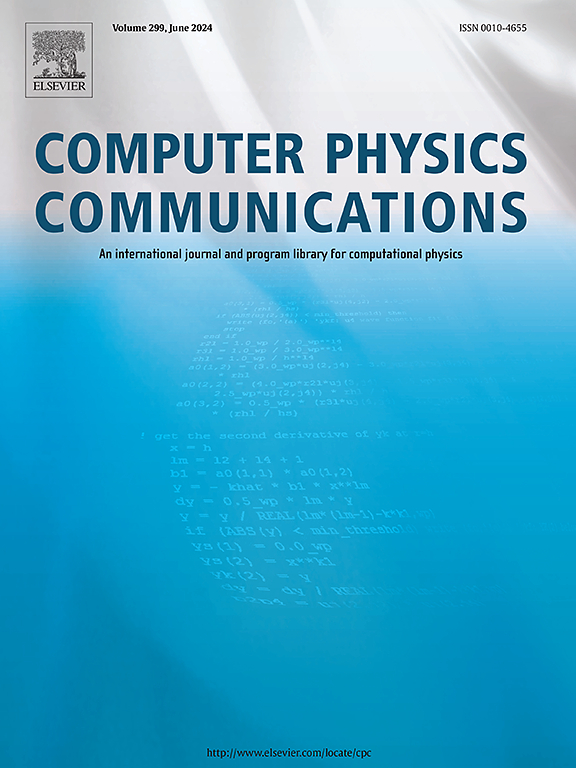Q-POP-IMT:用于模拟量子材料中绝缘体-金属转变过程的开源相场软件
IF 3.4
2区 物理与天体物理
Q1 COMPUTER SCIENCE, INTERDISCIPLINARY APPLICATIONS
引用次数: 0
摘要
量子材料中的绝缘体-金属跃迁在场效应晶体管和神经形态计算等领域具有重要的潜在应用。在这里,我们介绍了Q-POP-IMT模块的初始版本,这是一个开源相场软件,用于模拟量子材料中绝缘体-金属转变的介观非平衡过程。Q-POP-IMT利用有限元方法求解了描述中尺度绝缘体-金属相变的相场演化方程。它目前利用强大的FEniCS库来定义和解决有限元问题。由于采用了有限元方法,该代码可以处理一般的边界条件,例如与实验和应用中最常见的设置之一相对应的复杂积分边界条件。我们通过模拟一种典型相关材料二氧化钒中类似神经元的电压自振荡现象来演示代码的使用。程序摘要程序标题:量子相场开源包-绝缘体-金属过渡(Q-POP-IMT)CPC库链接到程序文件:https://doi.org/10.17632/p3395559s6.1Developer's存储库链接:https://github.com/DOE-COMMS/Q-POP-ModulesLicensing条款:mit编程语言:python问题性质:相关量子材料在高温下经常表现出绝缘体-金属的转变,在神经形态计算、场效应晶体管等领域有着令人着迷的应用。理解绝缘体-金属相变并设计其应用需要了解此类电子相变的介观、非平衡、非均匀过程。求解方法:Q-POP-IMT代码实现了量子材料中绝缘体-金属相变的相场方程,描述了这种相变的介观、非平衡、非均匀动力学。采用有限元法求解耦合非线性偏微分方程。本文章由计算机程序翻译,如有差异,请以英文原文为准。
Q-POP-IMT: An open-source phase-field software for simulating insulator-metal transition processes in quantum materials
Insulator-metal transitions in quantum materials have important potential applications in areas such as field-effect transistors and neuromorphic computing. Here we present an initial release of the Q-POP-IMT module, an open-source phase-field software for simulating mesoscopic, nonequilibrium processes of insulator-metal transitions in quantum materials. Q-POP-IMT solves the phase-field equations of evolution that describe insulator-metal transitions at the mesoscale using the finite element method. It currently utilizes the powerful FEniCS library to define and solve finite element problems. Thanks to the finite element method, the code can address general boundary conditions such as a complex integral boundary condition corresponding to one of the most common setups in experiments and applications. We demonstrate the usage of the code through simulating the neuron-like voltage self-oscillation phenomenon in a prototypical correlated material, vanadium dioxide.
Program summary
Program Title: Quantum Phase-field Open-source Package - Insulator-Metal Transitions (Q-POP-IMT)
CPC Library link to program files: https://doi.org/10.17632/p3395559s6.1
Developer's repository link: https://github.com/DOE-COMMS/Q-POP-Modules
Licensing provisions: MIT
Programming language: Python
Nature of problem: Correlated quantum materials often exhibit insulator-metal transitions at high temperatures, which have fascinating applications in neuromorphic computing, field-effect transistors, etc. Understanding insulator-metal transitions and designing their applications require the knowledge of the mesoscopic, nonequilibrium, inhomogeneous processes of such electronic phase transitions.
Solution method: Q-POP-IMT code implements the phase-field equations of insulator-metal transitions in quantum materials, which describe the mesoscopic, nonequilibrium, inhomogeneous dynamics of such phase transitions. It uses the finite element method to solve the coupled nonlinear partial differential equations.
求助全文
通过发布文献求助,成功后即可免费获取论文全文。
去求助
来源期刊

Computer Physics Communications
物理-计算机:跨学科应用
CiteScore
12.10
自引率
3.20%
发文量
287
审稿时长
5.3 months
期刊介绍:
The focus of CPC is on contemporary computational methods and techniques and their implementation, the effectiveness of which will normally be evidenced by the author(s) within the context of a substantive problem in physics. Within this setting CPC publishes two types of paper.
Computer Programs in Physics (CPiP)
These papers describe significant computer programs to be archived in the CPC Program Library which is held in the Mendeley Data repository. The submitted software must be covered by an approved open source licence. Papers and associated computer programs that address a problem of contemporary interest in physics that cannot be solved by current software are particularly encouraged.
Computational Physics Papers (CP)
These are research papers in, but are not limited to, the following themes across computational physics and related disciplines.
mathematical and numerical methods and algorithms;
computational models including those associated with the design, control and analysis of experiments; and
algebraic computation.
Each will normally include software implementation and performance details. The software implementation should, ideally, be available via GitHub, Zenodo or an institutional repository.In addition, research papers on the impact of advanced computer architecture and special purpose computers on computing in the physical sciences and software topics related to, and of importance in, the physical sciences may be considered.
 求助内容:
求助内容: 应助结果提醒方式:
应助结果提醒方式:


